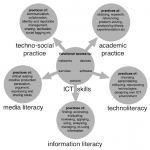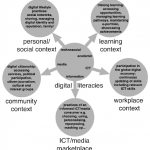Umbrella terms and micro-literacies
This is is the first draft of a section for my Ed.D. thesis; please don’t quote it as it’s not the final version.
The bibliography relating to the referenced literature can be found at http://dougbelshaw.com/thesis (I’ve blogged more about my thesis at http://dougbelshaw.com/blog)
Perhaps due to the fragmentation of research outlined earlier, many theorists seek to demarcate new forms of literacy. Once this has been done, they explain it in detail, and then assert its status as an over-arching literacy containing many sub- (or micro-) literacies. There is, they claim ‘one literacy to rule them all’.
Information literacy can been seen as one such ‘umbrella term’:
In the last decade a variety of “literacies” have been proposed… All of these literacies focus on a compartmentalized aspect of literacy. Information literacy, on the other hand, is an inclusive term. Through information literacy, the other literacies can be achieved. (Doyle, 1994, my emphasis)
Other theorists propose various ‘literacies’ as being the true umbrella term, the synthesising concept. Potter (2004:33), for example, states, ‘Reading literacy, visual literacy and computer literacy are not synonyms for media literacy; instead, they are merely components.’ It is perhaps most transparently and obviously stated in this definition of transliteracy:
Our current thinking (although still not entirely resolved) is that because it offers a wider analysis of reading, writing and interacting across a range of platforms, tools, media and cultures, transliteracy does not replace, but rather contains, “media literacy” and also “digital literacy.” (Thomas, et al. 2007, my emphasis)
In this way theorists not only deal with the third condition outlined in an earlier chapter – that of the status of a particular literacy in relation to other metaphorical concepts – but they can claim the credit of, at least partially solving the ‘literacy problem.’ The umbrella term in the late 1980s until the turn of the century tended to be ‘information literacy,’ now superseded by references to ‘media literacy’:
Reading literacy, visual literacy and computer literacy are not synonyms for media literacy; instead, they are merely components. (Potter, 2004, p.33)
Potter’s use of the word ‘merely’ above (‘visual literacy and computer literacy… are merely components’) betrays here what is only latent in other examples of writers using umbrella terms. That is to say, each comes at the issue from a particular point of view and with a particular bias and background. Each assumes that the particular literacy for their field of interest or specialisation is the ‘umbrella literacy.’ There is also an unfortunate element of theorists inventing terms in the hope that it may gain traction and they become synonymous with it. Perhaps the best example of this is the clumsy concept of ‘Electracy’ we came across in Chapter 2, as defined by Erstad:
‘Electracy’ is a term that combines different forms of literacy related to the use of new technologies; for example ‘media or multimedia literacy’, ‘computer literacy’, ‘information literacy’and ‘visual literacy’. It could be described as literacy for a post-typographic world (Reinking et al., 1998)… Electracy is something young people develop by growing up in a digital culture, and their education is supposed to include their efforts to create knowledge and learning. (Erstad, 2003:11)
Whilst at first glance this sounds insightful and promising it is an empty term, signifying nothing concrete. How are these literacies combined? How do young people ‘develop’ Electracy by ‘growing up a in digital culture? Surely all education is about ‘knowledge and learning’? Whilst Erstad attempts to use Tyner’s (1998) distinction between ‘tool literacies’ and ‘literacies of representations,’ Electracy as a term is not explained adequately enough to belong to either group.
Even though information literacy is an established term, it is so broad and ambiguously applicable that it too can be considered as an umbrella term. Fieldhouse and Nicholas (in Lankshear & Knobel, 2008) use a slightly different strategy in order to promote their tangential concept of being ‘information savvy.’ Instead of the latter being an umbrella term in its own right, they present it as being the other half of the jigsaw puzzle to ‘digital literacy’ in order for individuals to be ‘information literate.’
[I will have a graphic here in my thesis showing digital literacy and being ‘information savvy’ as part of a ‘information literacy’ jigsaw]
Fieldhouse and Nicholas (2008) use a rather jaded yet convenient dichotomy of ‘digital natives’ and ‘digital immigrants’ – terms coined by Prensky (2001). The idea is that those who grow up with digital technologies ‘speak the language’ as a native. On the other hand, ‘digital immigrants’ betray their age and lack of experience by ‘speak[ing] a language which reflects their experience of pre-digital life, by describing things as “digital” to differentiate between electronic and traditional versions’ (Fieldhouse & Nicholas, 2008:60). However, whilst the dichotomies the authors use are interesting in helping frame the debate, they neither settle on one definition of digital literacy nor rescue the concept of being ‘information savvy’ from being an interesting colloquialism.
In order to ‘reconcil[e] the claims of myriad concepts of digital literacy, a veritable legion of digital literacies’ (Lankshear & Knobel, 2008:4) some wishing to employ an umbrella term have instead turned to the notion of ‘competency’ or ‘competencies.’ The Oxford English Dictionary defines being ‘competent’ as:
adjective 1 having the necessary skill or knowledge to do something successfully. 2 satisfactory or adequate, though not outstanding: she spoke quite competent French. 3 having legal authority to deal with a particular matter.
It is the first of these definitions targetted by those who would rather concentrate on ‘competence’ than ‘literacy’. For example, Spitzer (1998) quotes the following 1995 definition of ‘information competence’ from the Work Group on Information Competence, Commission on Learning Resources and Instructional Technology:
Information competence is the fusing or the integration of library literacy, computer literacy, media literacy, technological literacy, ethics, critical thinking, and communication skills. (Spitzer, 1998, p.25)
No explanation, however, is given as to what ‘information competence’ would look like in practice nor is guidance given as to how one would go about achieving it (if it is a ‘state’) or entering into it (if it is a ‘process’). Similarly prone to failure is Savolainen’s (2002, quoted in Virkus, 2003) suggestion of ‘information-related competencies’ as an umbrella term, covering ‘information literacy, media competence and library skills.’ His justification for suggesting such a term is:
[b]ecause new labels describing specific kinds of literacies are continually introduced, reflecting the developments of ICTs, the attempts to develop an exact classification of information-related literacies seem to be futile. (Savolainen, 2002 – quoted in Virkus, 2003).
No explanation is given, however, as to how or why using the term ‘information-related competencies’ is useful in any way, apart from being a shorthand for a number of arbitrary micro literacies deemed important by the author. If an umbrella term is to be employed there must a rationale for doing so.
Instead of attempting to come up with an umbrella (‘macro’) term in which to retro-fit micro literacies, it seems to make more sense for theorists to use ‘new literacies’ as a shorthand – as indeed many already have begun to do (see, for example, Beavis, 1998; Kress, 2003; Lankshear & Knobel, 2006). Separating out the multitude of literacies seems, as Tyner states, somewhat artificial as they overlap to such a great extent. Whilst they can be separated, this should only be done for positive purposes:
The need to set one literacy apart from another can only be explained by a need to use the concepts for other reasons, that is, to strengthen the professional status of its constituencies, or to take issue with the approaches used by proponents. (Tyner, 1998:104)
Our focus instead should perhaps instead be upon a particular literacy as an ‘integrating (but not overarching) concept that focuses upon the digital without limiting itself to computer skills and which comes with little historical baggage’ (Martin, 2006 quoted in Bawden, 2008:26). Here Martin seems to have in mind the concept of ‘digital literacy’ although it is not the name of the term that is the issue. Instead, it is its explanatory power and utility in terms of conceptual understanding and applicability that is key.
Interestingly, Martin (2008:156-7) lists the following as ‘literacies of the digital,’ hinting that his earlier (2006) thinking has evolved towards considering literacies as an overlapping matrix:
- Computer, IT or ICT Literacy
- Technological Literacy
- Information Literacy
- Media Literacy
- Visual Literacy
- Communication Literacy
- Digital Literacy
Although he does not use the term ‘matrix,’ it seems clear that Martin has something like this in mind. If so, then the above list contains are only a few of a potential Pandora’s box of ‘literacies.’ With no-one as the gatekeeper as to what constitutes a ‘literacy of the digital’ a recursive problem occurs: there is nothing to stop a macro literacy, integrative literacy or a matrix of literacies from themselves being seen as part of a bigger picture. New literacies, as Reilly (1996:218) states, seem to be created as soon as a ‘new texts’ are invented or conceived. Martin needs to be explicit as to whether new forms of ‘text’ necessarily mean new forms of literacy.
It is also unclear as to whether Martin sees these as being ‘wholly’ digital literacies or whether they have digital elements. If it is the former, then he would have to explain how, for example, ‘communication literacy’ differs in the digital and analogue domains. If it is the latter, Matin should explain which elements of these literacies do indeed count as ‘digital’.
JISC, the UK body funded by the Higher Education Funding Council for England (HEFCE), is beginning a programme of work in the area of Digital Literacies after preliminary work in 2009 on ‘Learning Literacies in a Digital Age’. This is important because of the influence JISC has on the Higher Education sector (in particular) in the UK. JISC work talks in terms of a matrix of literacies, predicated upon an understanding of ‘learning literacies’:
Our understanding of learning literacies encompasses the range of practice that underpin effective learning in a digital age. The phrase learning literacies expresses the tension between literacy as a generic capacity for thinking, communicating ideas and intellectual work – that universities have traditionally supported – and the digital technologies and networks which are transforming what it means to work, think, communicate and learn. (JISC, 2009a, p.2)
The work of JISC is heavily bound-up with institutional change and wider notions of graduate employability and the take up of e-learning technologies and ecosystems by the Higher Education sector. The definition of ‘digital literacy’ used by JISC is, therefore, perhaps purposely vague: “the range of practices that underpin effective learning in a digital age” or, elsewhere, using the EC’s definition: “the confident and critical use of ICT for work, leisure, learning and communication.” The first of these definitions incorporates academic practices, information literacy, media literacy and ICT skills, amongst others (JISC, 2009b, p.1). The second definition is represented in the following diagram that sits half-way between a matrix of literacies and an ‘umbrella term’:
(click to enlarge)
Whilst Martin’s matrix considers literacies to be ‘overlapping’ this diagram shows ‘digital competence’ (or ‘ICT skills’) to be foundational for further work in academic practice and media literacy (for example).
A further diagram demonstrates how these ‘spokes’ are themselves foundational to wider contexts. In this way, digital literacies are comprised of the literacy practices predicated upon ICT skills:
(click to enlarge)
One of the issues here is that micro-literacies, as defined above, are seen as flowing out of ICT skills, rather than out of the contexts. Although too much should not perhaps be read into diagrams, the one-way relationship from skills to practice belies the complexity and interaction between contexts and the abilities/competencies to interact effectively with others within those contexts.
It is difficult to argue, however, with the pyramid created in the JISC Digital literacies development framework (JISC, 2009d). This places ‘Attributes/identities’ at the top of a pyramid charting stages of development, followed by ‘Practices’, ‘Skills’ and, at the bottom of the pyramid, ‘Functional access’. Access to digital devices is necessary to develop digital literacies, with skills coming from use. Practices, habits and mental models result from increasing use and immersion. Finally, a critical appreciation, resilience and adaptability and reflexive understanding of ‘digital identity’ constitutes the top of the pyramid. That is not to say, of course, that there is an inevitable trajectory from the bottom of the pyramid to the top merely through the use of digital technologies. Not only does the ‘ladder’ have many rungs, but those rungs (to extend the metaphor) change as technologies and accepted social practices move on.
An important piece of work around the (in)ability of students to apply their learning and practices from one area of their life to another is exemplified in JISC’s work on ‘Responding to Learners’ (JISC 2009c) This study demonstrated that students often demonstrated a mental disconnect between the social software they used personally and that which they used – or were allowed to use – in an academic context. In addition, some JISC work on the ‘Google Generation’ (JISC, 2008) demonstrated that, far from this being merely the fault of reactionary institutions, students were not the ‘Digital Natives’ that they were assumed to be by many educators.
Before being abolished in 2010 Becta, a UK government organisation to promote educational technology in schools, commissioned some work on Digital Literacy. Created by by Tabetha Newman, the framework is intended to move ‘from terminology to action’ (Newman, 2009) after a comprehensive literature review. The five-step process model is: Define, Access, Understand & Evaluate, Create, Communicate. This has strong echoes of moving up Bloom’s (revised) taxonomy (Krathwol & Anderson, 2001) and complements JISC’s pyramid model. Defining digital literacies is, in Newman’s model, merely the first step in the important job of operationalising a definition so that work around it makes a different in practice.
The method, up to this point, for those wishing to begin a programme of work around ‘New’ or ‘Digital’ Literacies seems to be to concentrate on one particular definition as an umbrella term. This serves as a focus, with other literacies, skills and competencies retro-fitted into this overarching term. The same is evident with concepts such as ‘21st century skills’. What may be more useful, however, is to consider digital literacies an semi-fluid matrix of overlapping literacies that change due to time and context. Whilst this does not allow for effective soundbites and fails the test of fitting nicely upon one PowerPoint slide it is, nevertheless, an ultimately more accurate and responsive approach.
- Anderson, L.W., et al. (2001) A Taxonomy for Learning, Teaching, and Assessing: A Revision of Bloom’s Taxonomy of Educational Objectives
- Bawden, D. (2008) ‘Origins and Concepts of Digital Literacy’ (in Lankshear, C. & Knobel, M.Digital Literacies: Concepts, Policies and Practices)
- Beavis, C. (1998) ‘Computer games, culture and curriculum’ (in I. Snyder, Page to Screen, 1998)
- Doyle, C.S. (1994) Information literacy in an information society: A Concept for the Information Age
- Erstad, O. (2003) ‘Electracy as empowerment: Student activities in learning environments using technology’ (Young, 11:11, 2003)
- Fieldhouse, M. & Nicholas, D. (2008) ‘Digital Literacy as Information Savvy: the road to information literacy’ (in Lankshear, C. & Knobel, M. Digital Literacies: Concepts, Policies and Practices)
- JISC (2008) ‘Google Generation’ is a myth, says new research
- JISC (2009a) Learning Literacies in a Digital Age
- JISC (2009b) Digital literacies Pilot materials
- JISC (2009c) Responding to Learners Pack
- Kress, G. (2003) Literacy in the New Media Age
- Krathwohl, D.R. & Anderson, L.W. (2001) A Taxonomy for Learning, Teaching, and Assessing: A Revision of Bloom’s Taxonomy of Educational Objectives
- Lankshear, C. & Knobel, M. (2006) – New Literacies: Everyday Practices and Classroom Learning
- Martin, A. (2008) ‘Digital Literacy and the “Digital Society”‘ (in Lankshear, C. & Knobel, M., Digital Literacies: Concepts, Policies and Practices)
- Newman, T. (2009) Consequences of a digital literacy review: from terminology to action
- Potter, W.J. (2004) Theory of Media Literacy
- Reilly, B. (1996) ‘New Technologies, New Literacies, New Patterns’ (in C. Fisher, D.C. Dwyer & K. Yocam (eds.), Education and Technology: reflections on computing in classrooms)
- Spitzer, K.L., et al. (1998) Information Literacy: essential skills for the information age
- Thomas, et al. (2007) ‘Transliteracy: Crossing divides’ (First Monday, 12:12. December 2007)
- Tyner, K.R. (1998) Literacy in a Digital World: Teaching and Learning in the Age of Information
- Virkus, S. (2003) ‘Information literacy in Europe: a literature review’ (Information Research, Vol. 8 No. 4, July 2003)



